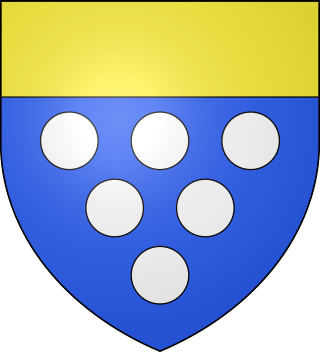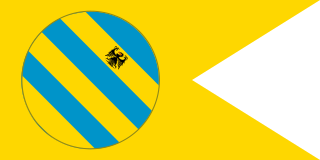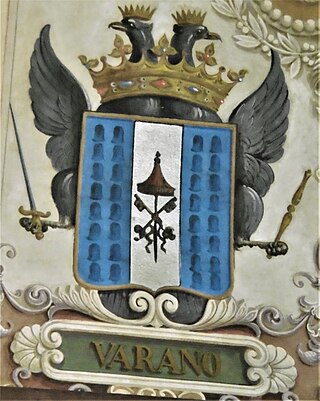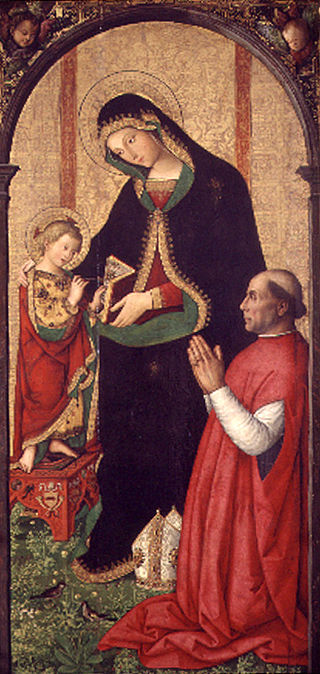
Cesare Borgia was an Italian cardinal and condottiero, an illegitimate son of Pope Alexander VI and member of the Spanish-Aragonese House of Borgia. His fight for power was a major inspiration for The Prince by Niccolò Machiavelli.

Pope Alexander VI was head of the Catholic Church and ruler of the Papal States from 11 August 1492 until his death in 1503. Born into the prominent Borgia family in Xàtiva in the Kingdom of Valencia under the Crown of Aragon, Rodrigo studied law at the University of Bologna. He was ordained deacon and made a cardinal in 1456 after the election of his uncle as Pope Callixtus III, and a year later he became vice-chancellor of the Catholic Church. He proceeded to serve in the Curia under the next four popes, acquiring significant influence and wealth in the process. In 1492, Rodrigo was elected pope, taking the name Alexander VI.

Pope Julius II was head of the Catholic Church and ruler of the Papal States from 1503 to his death, in February 1513. Nicknamed the Warrior Pope, Battle Pope or the Fearsome Pope, he chose his papal name not in honour of Pope Julius I but in emulation of Julius Caesar. One of the most powerful and influential popes, Julius II was a central figure of the High Renaissance and left a significant cultural and political legacy. As a result of his policies during the Italian Wars, the Papal States increased their power and centralization, and the office of the papacy continued to be crucial, diplomatically and politically, during the entirety of the 16th century in Italy and Europe.

The House of Borgia was a Spanish noble family, which rose to prominence during the Italian Renaissance. They were from Xàtiva, Kingdom of Valencia, the surname being a toponymic from the town of Borja, then in the Crown of Aragon, in Spain.

The House of Montefeltro is the name of a historical Italian family who ruled Urbino and Gubbio and became Dukes of Urbino in 1443. The family extinguished in the male line in 1508 and the duchy was inherited by the Della Rovere family.
Duke of Valentinois is a title of nobility, originally in the French peerage. It is currently one of the many hereditary titles claimed by the Prince of Monaco despite its extinction in French law in 1949. Though it originally indicated administrative control of the Duchy of Valentinois, based around the city of Valence, the duchy has since become part of France, making the title simply one of courtesy.

The Count of Valentinois was originally the official in charge of the region (county) around Valence. It evolved in a hereditary title of nobility, still indicating control of the Valentinois and often of the Diois. The title later became the Duke of Valentinois.

Prince of Foxes is a 1947 historical novel by Samuel Shellabarger, following the adventures of the fictional Andrea Orsini, a captain in the service of Cesare Borgia during his conquest of the Romagna.
Duke of Camerino is a title of nobility, originally in Papal peerage. It was created on 1503 by Apostolic authority of Pope Alexander VI and cardinal council over the ancient Marquissate of Camerino, which was part of the Dukedom of Spoleto.

The Duchy of Urbino was an independent duchy in early modern central Italy, corresponding to the northern half of the modern region of Marche. It was directly annexed by the Papal States in 1631.
Giovanni Borgia, known as the Infans Romanus, was born into the House of Borgia in secret and is of unclear parentage. Speculations of the child's parentage involve either Lucrezia Borgia with her alleged lover, Perotto Calderon or Cesare Borgia, or Pope Alexander VI as his father. Cesare Borgia's biographer Rafael Sabatini says that the truth is fairly clear: Alexander fathered the child with an unknown Roman woman.

The Da Varano was an Italian noble family who had an important role in the medieval and Renaissance history of central Italy, as rulers of Camerino and other lands in the Marche and Umbria.

Francisco de Borja y Navarro de Alpicat was a Spanish cardinal, and the seventh of ten cardinal-nephews created by Pope Alexander VI.

Charlotte of Albret, Dame de Châlus, was a wealthy French noblewoman of the Albret family. She was the sister of King John III of Navarre and the wife of the widely notorious Cesare Borgia, whom she married in 1499. She was the mother of his only legitimate child, Louise Borgia, to whom she acted as regent of the Duchy of Valentinois following the death of Cesare from 1507 to 1514.

Pier Luigi de Borgia, 1st Duke of Gandía was a Valencian noble. Pier Luigi was the son of Cardinal Rodrigo Borgia, and an unknown free-woman. He was half-brother of, among others, Isabella Borgia and Girolama Borgia, born by unknown mothers, and Cesare Borgia, Giovanni Borgia, Lucrezia Borgia and Goffredo Borgia, all born by Vannozza Cattanei.
Juan Domingo de Borja y Doncel was the father of future Pope Callixtus III. He held the title over the Barony La Torre de Canals. He was a member of the House of Borja.

The papal nobility are the aristocracy of the Holy See, composed of persons holding titles bestowed by the Pope. From the Middle Ages into the nineteenth century, the papacy held direct temporal power in the Papal States, and many titles of papal nobility were derived from fiefs with territorial privileges attached. During this time, the Pope also bestowed ancient civic titles such as patrician. Today, the Pope still exercises authority to grant titles with territorial designations, although these are purely nominal and the privileges enjoyed by the holders pertain to styles of address and heraldry. Additionally, the Pope grants personal and familial titles that carry no territorial designation. Their titles being merely honorific, the modern papal nobility includes descendants of ancient Roman families as well as notable Catholics from many countries. All pontifical noble titles are within the personal gift of the pontiff, and are not recorded in the Official Acts of the Holy See.

Prince of Tricarico is a title created by Alfonso II of Naples for Giovanni Borgia, second duke of Gandía, son of Pope Alexander VI and Vanozza Catanei in 1494. He was also named Prince of Treano and Duke of Benevento for having supported the Pope in the war against the Orsini family.

Count of Die, Diois or Dyois is a title of nobility, originally in the French peerage.

Niccolò Bonafede was a Roman Catholic prelate who served as Bishop of Chiusi (1504–1533).
















